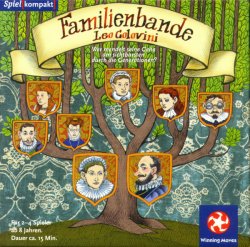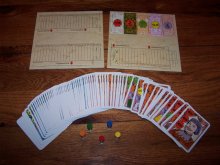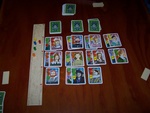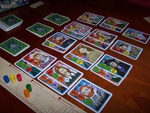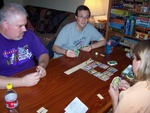
|
Familienbande A game by Leo Colovini Published by Winning Moves Players: 2 to 4 Time: 20-30 minutes Reviewed by Susan Rozmiarek |

|
The name of this card game translates to English as "Family Ties." The theme is one of filling out five generations of a family tree. Each card depicts either a woman or a man along with three family trait symbols. The symbols on the card are any combination of several types - noses, eyeglasses, curly hair, lips, and ears. Each trait is also represented by a color, making them easier to distinguish as well as to match a scoring marker on the score track. Players are secretly assigned one of the traits at the start of the game, similar to another Colovini design, Clans. The individual traits will score points during the game, as cards are played, and their corresponding markers moved accordingly along the score track. At the end of game, players reveal their assigned trait with the victor being the player whose trait has scored the most points.
Components:
- 70 cards, each depicting a family member and evenly divided between male and female
- 1 scoring track composed of three parts that interlock together
- 5 family trait tiles
- 5 cylindrical wooden markers, each a different color to match a different trait
The tiles, scoring track and cards are all of excellent quality, but I have a major quibble with the scoring track and markers. The cylindrical markers are way too wide to fit in the spaces of the scoring track, making it hard to keep an accurate score, especially if the track gets bumped. This is very annoying.
The art on the cards is pretty goofy, but it fits the light nature of the game. There can be a bit of trouble distinguishing genders, but a blue versus a pink sash in the background clears up any confusion.
Game play:
Players are dealt a starting hand of five cards and three cards are flipped up for the first generation.
On his turn, a player does one of the following actions:
- Causes a marriage by playing a card of the opposite sex on a single card already on the table. He then draws a card, ending his turn. No points are scored. Note: People in the fifth and final generation cannot marry.
- Create a descendent by playing a card in the next generation (row) below a row containing eligible parents. To be eligible, the parents must show, between them, all three of the descendant's traits. Each trait symbol depicted on the card of the descendant now scores, depending on the generation in which it located - two points for the second, three points for the third, and so on. The player does NOT draw a card and his turn is over. Note: Each generation can only have one more person than the generation before it. When a generation is full, the row above it is turned over and no more marriages or descendants can be produced from it.
- Pass and draw a card.
When the seventh descendent in the fifth generation is played and scored, the game is over immediately and each player's secret trait is revealed. Now here's the kicker. Cards still in your hand count as negative points. The first card is -1, the second -2, the third -3, etc. These are added together and subtracted from the final scores. So just having four cards leftover costs a player ten points. Brutal! The only way to decrease your hand size is by playing descendants and possibly scoring others' traits. On the other hand, you'll be tempted to draw cards, increasing your hand size, fishing for ones that will score your trait. This can be agonizing at times, especially when the threat of the game ending is near.
Holding on to a card that depicts three of your traits while trying to set up eligible parents to play it as a descendent in a later, higher scoring generation seems to be a good strategy. This is, of course, if you are lucky enough to draw the right cards. Therein, lies a problem with this game. It is very luck dependent and chaotic, making planning difficult. On the other hand, it's quick and fun to watch develop. There were a lot of laughs as people mistakenly tried to marry people of the same gender or produce out-of-wedlock descendents. Those situations are not allowed in the rules, of course. The game would be too easy if they were.
I liked the game with more players rather than fewer. There is perhaps more chaos, but with more of the traits secretly belonging to players, there's more bluffing and tension. Playing with two players, there are three traits not belonging to anyone scoring and this is not nearly as interesting, even if you do feel you have more control with less turns between yours.
Summary:
I was very surprised with this game.
Being a Leo Colovini design, I was expecting a dry, abstract "thinking" game.
While I have by no means played all of his previous games, the ones that I'm most familiar with,
such as Meridian, Bridges of Shangri-La, Magna Grecia, and Alexandros, fit this description.
Familienbande is a big departure from that type of game, being a light, "filler" game with a humorous feel.
It is not a great game, but it is a decent enough game of this type.
It is very luck-dependent, but it is quick to play and fun to watch as you do.
The game is easy to learn and would be a good choice for casual or family gamers.
I imagine that my own gaming group will enjoy quite a few plays before we tire of it.
| Other Web information: |
This page viewed
E-mail Ed Rozmiarek with questions or problems concerning this page.
Copyright © 2004, Ed & Susan Rozmiarek No portion of this website may be reproduced or copied without the consent of Ed or Susan Rozmiarek.
